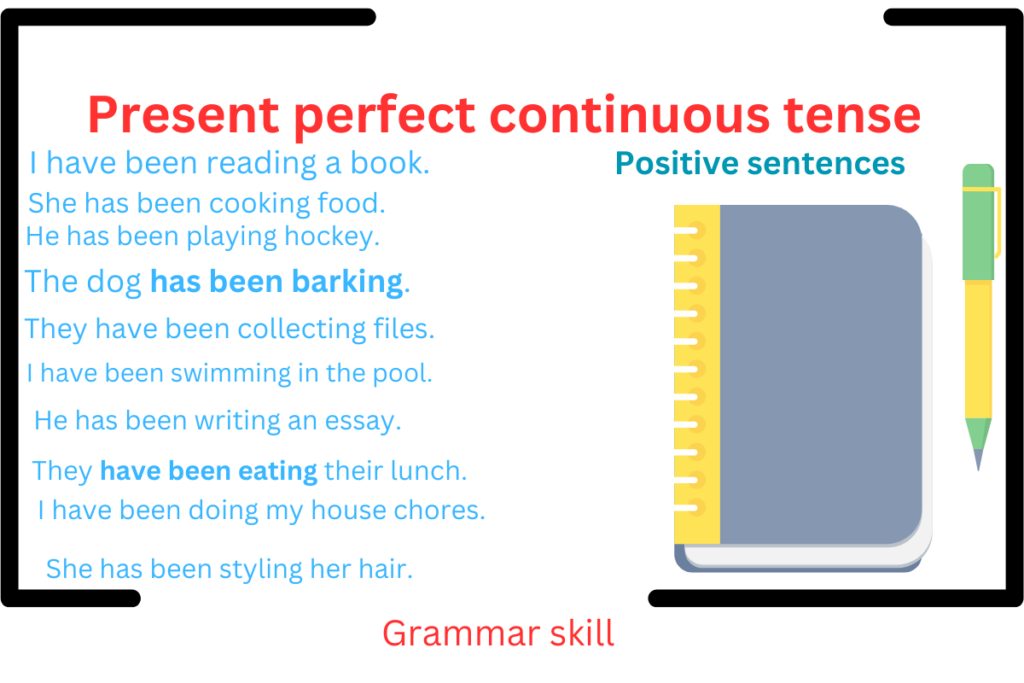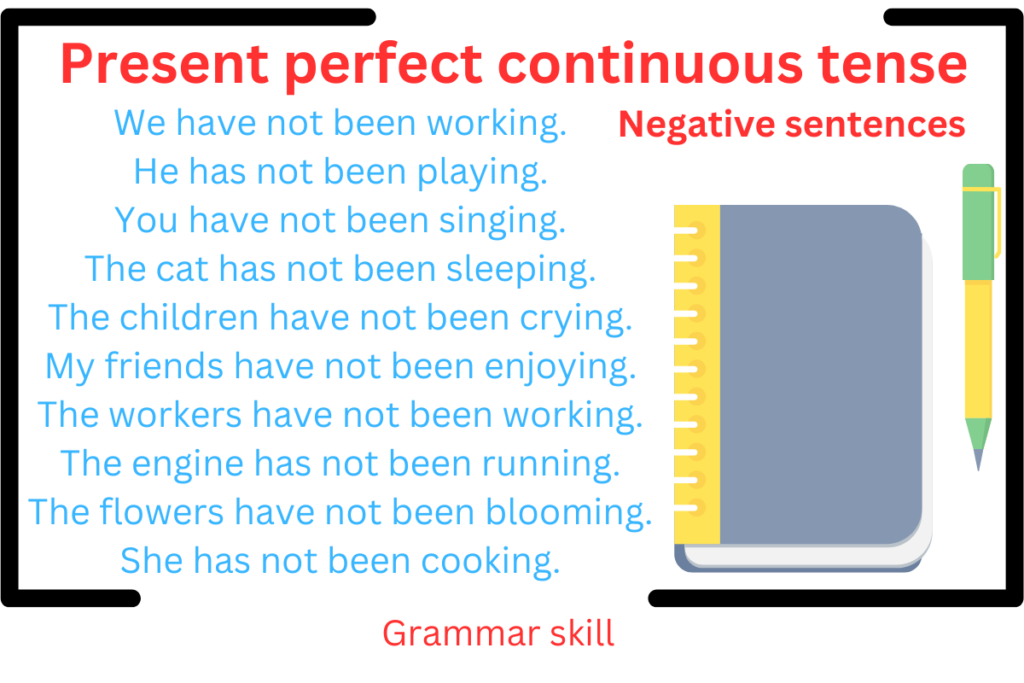The Present Perfect Continuous tense brings a unique conversations, duration and ongoing nature of activities. For instance, in a sentence such as “I have been reading that book for three days,” the speaker not only highlights their current involvement but also frames it within an ongoing timeline. Here, the importance lies on both the action itself and its persistence, inviting listeners to appreciate not just what has happened but how long it has been come about.
Example Sentences of Present Perfect Continuous Tense
Positive Example Sentences
| Sentences structure | Subject+ has/have+ been+ verb( ing )+ object |
- I have been reading a book.
- She has been cooking food.
- He has been playing hockey.
- The dog has been barking.
- They have been collecting files.
- I have been swimming in the pool.
- He has been writing an essay.
- They have been eating their lunch.
- I have been doing my house chores.
- She has been styling her hair.

Negative Examples of Present Perfect Continuous Tense
| Sentences structure | Subject + has/ have + not + been +verb ( ing) + object |
- We have not been working.
- He has not been playing.
- You have not been singing.
- The cat has not been sleeping.
- The children have not been crying.
- My friends have not been enjoying.
- The workers have not been working.
- The engine has not been running.
- The flowers have not been blooming.
- She has not been cooking.
- They have not been running.
- We have not been fighting.
- He has not been racing.
- I have not been cutting.
- She has not been managing.
- They have not been eating.
- We have not been hunting.

Interrogative Examples
| Sentences structure | has/ have + subject + been + verb( ing ) + object? |
- Have I been reading?
- Has she been studying?
- Have they been fighting?
- Have we been writing?
- Has he been abusing?
- Have they been singing?
- Has the dog been barking at you?
- Have the kids been watching cartoon?
- Have my parents been visiting my school?
- Has the teacher been teaching?
- Has the car been running with speed?
- Have the birds been flying?
- Has she been sewing?
- Have they been jumping?
- Have we been washing?
- Has he been dieting?
- Have I been drawing?
- Has she been stitching?
- Have they been dancing?
- Have we been painting?
Negative Interrogative Examples
| Sentences Structure | Has/Have + subject + not + been + verb(ing) + object? |
- Have I not been knitting?
- Has she not been drinking?
- Have they not been traveling?
- Have we not been gaming?
- Has he not been studying?
- Have you not been talking?
- Has the cat not been sleeping?
- Have the children not been practicing?
- Have my friends not been driving?
- Have the workers not been working?
- Has the engine not been running?
- Have the flower not been blooming?
- Has she not been stitching?
- Have they not been dieting?
- Have we not been riding?
- Has he not been jogging?
- Have I not been sketching?
- Has she not been managing?
- Have they not been visiting?
- Have we not been hunting?
FAQs
.What is the present perfect continuous tense and examples?
The present perfect continuous tense is a verb form used to describe actions that began in the past and continue into the present,
- When to use present perfect continuous?
The present perfect continuous tense is used to the duration of an action that started in the past and continues into the present or has recently stopped but still has important mater to the hand.
- What is the difference between present perfect and present perfect continuous?
The present perfect and present perfect continuous tenses both relate to situations that connect the past with the present, but they special different aspects of those actions.
Conclusion
The present perfect continuous tense serves as a powerful tool in English grammar, allowing speakers to deserve special attention the ongoing nature of actions that started in the past and continue to the present. By mastering this tense, learners can convey not only the duration of an activity but also its relevance to current situations. This aspect is particularly useful in both spoken and written communication, enhancing clarity and engagement.
